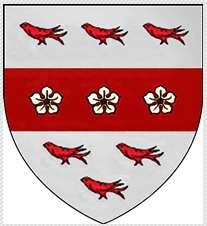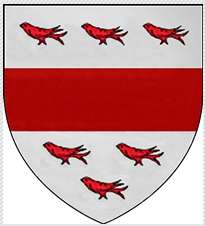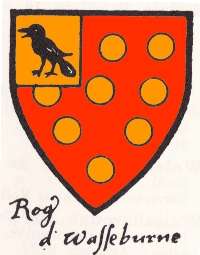Washburn


Washburn (alternatively Wasseburne, Wasseborne, Wasshebourne, Wassheborne, Washbourne, Washburne, Washborne, Washborn, Wasborn, Washbon, Washman, etc.) is a toponymic surname, probably of Old English origin, with likely Anglo-Norman and Norman-French influences after the Conquest, as the name evolved.
The family, of Norman origin, can be traced through the lands in Worcestershire and Gloucestershire, England called "Little Washbourne" and "Great Washbourne". Little Washbourne, in the Parish of Overbury, Co. Worcester, and the manor thereon, eventually became known as "Knights Washbourne", for the many from this line that bore that honour. In the Herald's College, London, Vol. I., page 54, is given: Washbourne. "A name of ancient Norman descent; the founder was knighted on the field of battle by William the Conqueror and endowed with the lands of Little Washbourne and Great Washbourne, Counties of Gloucester and Worcester".
The name may have come from the Saxon for "from the flooding brook,"[1] with "wash" meaning "swift moving current of a stream," and "burn" referring to a brook or a small stream. It may have originated from the River Isbourne, which flowed near Little and Great Washbourne, or it may have originated from Waseborn in Devonshire.
The Washburn name and variations
The name was anciently "Wasseburn" or "-born". C. W. Bardsley's Dictionary of English and Welsh Surnames states that "Wasse" was anciently and still is a common surname in Yorkshire. It is a place name derived from the various river and sea beaches subject to overflow by floods and tides, hence known as wasses and now as cashes. "Wasseburn" signified a flowing stream. The little ham that stood upon its banks took its name from the stream, and the proprietor or lord of the village was so and so de Wasseborn, just as the parson was the most important person in the parish. The form "Wasseborn" is the form first met with about 1100; and "Wasseborn" or "-burn" continued in common use by the family with the occasional addition of a final "e" until about the middle of the 17th century when the family wrote the name "Washbourne", a form which still prevails in England.
Through all the first two periods, writers of public documents, even of wills, felt themselves at liberty to suit their own convenience or taste in spelling the name, so that great varieties of spelling are found in public documents and varieties in the same document. Thus in the will of John Washburn of Bengeworth, it is "Wassheburns"; in his wife's "Wasborn"; in his son's "Wasburne" and in the inventory "Wasborne"; in the burgess' will "Washborne"; in his wife's "Wasburne" and "Washborne"; in the public registers of Bengeworth pretty uniformly "Wasborne". John the emigrant wrote his name "Washborn". In America three forms of spelling have prevailed - the most common "Washburn", "Washborn", and "Washburne", with even a greater variety of spelling of the name than is found in England, and not always by outsiders.[2]
The first of the name was Sir Roger d'Wasseburne, ancestor of the American immigrant Washburns' of Plymouth Colony. Washbourne Manor at Little Washbourne, was the ancient seat of the family, shown in Doomsday for that of Urse d'Abitot, and later recorded for Sir Roger d'Wasseburne, in the 1200s. Roger is shown as "of Washbourne, Stanford and Little Cumberton". His son Sir John d'Wasseburne, is recorded as "of Washbourne, Bretforton & Orleton in Estham". This Roger and John of the 1200s, are the first to use the surname.
Descendant in the male line of the "Knights Washbourne", the first American colonist of the family, being that of John Washborn (Sr.), b. 1597 in Bengeworth, England, came to Plymouth Colony in c. 1631. His son, John Washburn (Jr.), b. 1620, also in Bengeworth, sailed to New England in 1635 on the Elizabeth & Ann, with his mother and brother. He married in 1645, Elizabeth Mitchell, daughter of Experience and Jane (Cooke) Mitchell, of Duxbury, Plymouth Colony. She was the granddaughter of Francis Cooke, who sailed to America on the Mayflower. They settled first in Duxbury and had eleven children, including the first notable set of Seven Brothers, in the American Washburn line. It has been suggested that a likely 90% of the American Washburns hail from one of these "Seven Brothers".
Another contributor to the American Washburn line, a younger brother of John Sr., William Washburne, the immigrant ancestor to Connecticut Colony, and later Hempstead, Long Island, did not join his brother John Washburn in Plymouth Colony. He remained in England, where he raised a large family, and finally sailed with his in-laws to New England. They settled first in Stratford, Connecticut Colony, with the Nichols', eventually settling in Hempstead. He and his wife, Jane Nichols, had 9 or 10 children.
According to the 2000 U.S. Census, there were 19,505 Washburns in the United States, making it the 1,685th most common name in the country.[3] There are also a number of Washburns in Canada, many of whom are descendants of United Empire Loyalist Ebenezer Washburn.
Coat of arms

"Gules bezantée on a canton or a raven sable"
 The first coat of arms met with for this family were recorded in the St George's Roll, c. 1285 for Sir Roger d'Wasseburne. The blazon, "Gules bezantée on a canton or a raven sable", suggested to early writers a familial connection to the Houses of la Zouche ("Gules bezantée") and le Corbet ("Or a raven sable"), but this connection has yet to be corroborated. It is possible that these arms were borne, rather, in feudal homage to these Houses, but again, this possibility is conjecture. The later recording of these same arms is shown here, by Joseph Foster in 1902, and suggests a slightly different blazon, "Gules ten bezants 4, 3, 2, 1" for la Zouche. This is actually a very common variation in heraldry and is noted so in the description of the arms on the page for Zouche.
The first coat of arms met with for this family were recorded in the St George's Roll, c. 1285 for Sir Roger d'Wasseburne. The blazon, "Gules bezantée on a canton or a raven sable", suggested to early writers a familial connection to the Houses of la Zouche ("Gules bezantée") and le Corbet ("Or a raven sable"), but this connection has yet to be corroborated. It is possible that these arms were borne, rather, in feudal homage to these Houses, but again, this possibility is conjecture. The later recording of these same arms is shown here, by Joseph Foster in 1902, and suggests a slightly different blazon, "Gules ten bezants 4, 3, 2, 1" for la Zouche. This is actually a very common variation in heraldry and is noted so in the description of the arms on the page for Zouche.
"Argent a fess between six martlets gules"
 When the vast estates that Urse d'Abitot had accumulated were usurped from his son Roger, a substantial portion of the same, including the lands of Little Washbourne, were ultimately bestowed upon his sister's husband, Sir Walter Beauchamp of Elmley. The Washbourne family that resided at Little Washbourne thereafter, did so as under-tenants to their over-lords, the Beauchamps of Elmley Castle. The arms for this branch of Beauchamps' were "Gules a fess between six martlets or", as shown next.
When the vast estates that Urse d'Abitot had accumulated were usurped from his son Roger, a substantial portion of the same, including the lands of Little Washbourne, were ultimately bestowed upon his sister's husband, Sir Walter Beauchamp of Elmley. The Washbourne family that resided at Little Washbourne thereafter, did so as under-tenants to their over-lords, the Beauchamps of Elmley Castle. The arms for this branch of Beauchamps' were "Gules a fess between six martlets or", as shown next.
Sir John d'Wasseburne, formally of Dufford, son of Sir Roger, is the first Washbourne to be recorded as having borne the Beauchamp "a fess between six martlets" arms, changing the tincture's to the Washbourne colors of Argent and Gules as shown.
"Gules a fess between six martlets or"
 The arms for Sir Walter Beauchamp of Elmley Castle bore a red shield with gold fess and martlets, and the Washbournes' bore a silver shield with red charges, as shown above. This feudal homage was also borne by and recorded for several other families. Members of the Wysham, Walshe, Waleys, Burdett, Blount, Cardiff and other families all bore the "fess between six martlets" arms in differing tinctures. All of these other families are also recorded as marrying into the Beauchamp family.
The arms for Sir Walter Beauchamp of Elmley Castle bore a red shield with gold fess and martlets, and the Washbournes' bore a silver shield with red charges, as shown above. This feudal homage was also borne by and recorded for several other families. Members of the Wysham, Walshe, Waleys, Burdett, Blount, Cardiff and other families all bore the "fess between six martlets" arms in differing tinctures. All of these other families are also recorded as marrying into the Beauchamp family.
"Argent on a fess between six martlets gules three cinquefoils of the field"
 Washburn College in Topeka, Kansas, adopted a variation of this coat of arms, using creative license to alter the tinctures (colors), to its school's colors, and used it as its own logo. The college, originally chartered as "Lincoln College", changed its name to "Washburn College", after a substantial pledge was received from Massachusetts Industrialist Ichabod Washburn. Since becoming "Washburn University", the school has abandoned the Washburn Arms logo, now using a stylized "W" in its place. The school mascot "The Ichabods" is still in use.
Washburn College in Topeka, Kansas, adopted a variation of this coat of arms, using creative license to alter the tinctures (colors), to its school's colors, and used it as its own logo. The college, originally chartered as "Lincoln College", changed its name to "Washburn College", after a substantial pledge was received from Massachusetts Industrialist Ichabod Washburn. Since becoming "Washburn University", the school has abandoned the Washburn Arms logo, now using a stylized "W" in its place. The school mascot "The Ichabods" is still in use.
Washburns in Canada
- Ebenezer Washburn (1756–1826) - businessman and political figure in Upper Canada; member of the Legislative Assembly of Upper Canada; born in Attleboro, Massachusetts; a Tory loyal to the Crown; escaped to Quebec and eventually settled in Picton, Ontario
- Simon Ebenezer Washburn (1794–1837) - son of Ebenezer; born in Fredericksburgh Township, Ontario; alderman in Toronto; lawyer, clerk of the peace of the Home District, Ontario[4]
- Steve Washburn (born 1975) - ice hockey player; born in Ottawa, Ontario; played 93 games in the NHL for the Florida Panthers, Vancouver Canucks and the Philadelphia Flyers; currently playing in the Österreichischer Eishockeyverband
Washburns in the United States
- Israel Washburn, Sr. (1784–1876) - father of Israel, Jr., Elihu Benjamin, Charles Ames, and William D. Washburn; member of the Massachusetts House of Representatives (1815–16, 1818–19)
- Cephas Washburn (1793–1860) - noted Christian missionary and educator who worked with the Indians of northwest Arkansas and eastern Oklahoma; father of the painter Edward Washburn
- Ichabod Washburn (1798–1868) - owner of the world's largest wire mill, the Washburn and Moen Manufacturing Company, in Worcester, Massachusetts; co-founder of the Worcester Polytechnic Institute (1865); beneficiary and namesake of Washburn University (1865); church deacon
- Emory Washburn (1800–1877) - born in Leicester, Massachusetts; graduate of Dartmouth College and Williams College; studied law at Harvard; Massachusetts state representative (1826–28), state senator (1841–42) and governor (1854–55); for two decades, a popular professor at Harvard Law School; distant relation of Ichabod Washburn
- Israel Washburn, Jr. (1813–1883) - born in Livermore, Maine; son of Israel Washburn, Sr.; brother of Elihu Benjamin, Cadwallader Colden, Charles Ames and William D. Washburn; Member of Maine House of Representatives (1842); U.S. representative from Maine (6th District 1851-53, 5th District 1853-61); governor of Maine (1861–63)
- Peter Thacher Washburn (1814–1870) - born in Woodstock, Vermont; delegate to Republican National Convention from Vermont (1860); governor of Vermont (1869–70)
- Elihu Washburne (1816–1887) - "Watchdog of the Treasury"; born in Livermore, Maine; son of Israel Washburn, Sr.; nephew of Reuel Washburn; brother of Israel, Jr., Cadwallader Colden, Charles Ames and William D. Washburn; U.S. Representative from Illinois, 1853-69 (1st District 1853-63, 3rd District 1863-69); U.S. Secretary of State, 1869; U.S. Minister to France, 1869–77; candidate for Republican nomination for President, 1880; candidate for Republican nomination for Vice President, 1880
- Cadwallader Colden Washburn (1818–1882) - born in Livermore, Maine; son of Israel Washburn, Sr.; brother of Israel, Jr., Elihu Benjamin, Charles Ames and William D. Washburn; U.S. representative from Wisconsin (2nd District 1855-61, 6th District 1867-71); general in the Union Army during the Civil War; governor of Wisconsin (1872–74). Washburn County
- Cadwallader Lincoln Washburn (1866–1965) - born in Minneapolis, Minnesota; son of William Drew Washburn.;[5] noted deaf artist[6] and news correspondent who pioneered many new painting techniques in the west; the arts center at his alma mater Gallaudet College is named for him
- William Washburn (1820–1887) - born in Greenfield, Massachusetts; U.S. representative from Massachusetts 9th District, (1863–71); governor of Massachusetts (1872–74); U.S. senator from Massachusetts (1874–75)
- Charles Ames Washburn (1822–1889) - born in Livermore, Maine; son of Israel Washburn, Sr.; nephew of Reuel Washburn; cousin of Ganem W. Washburn; brother of Israel, Jr., Elihu Benjamin, Cadwallader Colden and William D. Washburn; went to California for the 1849 Gold Rush; presidential elector for California, 1860; U.S. diplomatic commissioner to Paraguay (1861–63); U.S. minister to Paraguay, 1863–68; novelist; invented an early typewriter
- William D. Washburn (1831–1912) - born in Livermore, Maine; son of Israel Washburn, Sr.; brother of Israel, Jr., Elihu Benjamin, Cadwallader Colden and Charles Ames Washburn; graduate of Bowdoin College (1854); Member of Minnesota House of Representatives (1861); U.S. representative from Minnesota (3rd District 1879-83, 4th District 1883-85); U.S. senator from Minnesota (1889–95); son William Drew Washburn, Jr.
- Edward Washburn (1831–1860) - artist; son of Indian missionary Cephas Washburn
- Henry Washburn (1832–1871) - born in Windsor, Vermont; general in the Union Army during the Civil War; U.S. representative from Indiana (7th District, 1866–69); as Surveyor-General of Montana Territory in 1870, led the Washburn Expedition into what is now Yellowstone National Park
- John Davis Washburn (1833–1903) - U.S. minister to Switzerland (1889–92)
- George Washburn (educator) (1833-1915) - born in Middleboro, Massachusetts; missionary and educator; president of Robert College
- Hempstead Washburne (1852–1918) - Mayor of Chicago, Illinois (1891–93)
- Charles Grenfill Washburn (1857–1928) - born in Worcester, Massachusetts; Member of Massachusetts House of Representatives (1897–98); member of Massachusetts Senate (1899–1900); U.S. representative from Massachusetts (3rd District, 1906–11)
- Frederick Leonard Washburn (1860–1927), zoology professor and State Entomologist of Minnesota
- Albert Henry Washburn (1866–1930) - U.S. minister to Austria (1922–30)
- Margaret Floy Washburn (1871–1939) - born in Harlem, New York; graduate of Vassar College (1891); Ph.D. Cornell University (1894); first woman to receive a doctorate in psychology; work focused on animal behavior and motor theory development; professor at Wells College, Cornell, the University of Cincinnati, and Vassar
- Bradford Washburn (1910–2007) - explorer, mountaineer, photographer, cartographer, and director of the Boston Museum of Science (1939–1980)
- George Washburn (1914-1979) - major league baseball player; born in Solon, Maine
- Barbara Washburn (1914-2014) - first woman to climb Mount McKinley (1947), the tallest mountain in North America; wife of Bradford
- James R. Washburn (1921-2007), member of the Illinois House of Representatives; mayor of Morris, Illinois
- Deric Washburn (born 1937) - screenwriter, Silent Running, The Deer Hunter, Extreme Prejudice, The Border
- Ray Washburn (born 1938) - born in Pasco, Washington; Major League Baseball pitcher with the St. Louis Cardinals (1961–1969) and Cincinnati Reds (1970)
- Ted Washburn (born 1941) - politician, member of the Montana House of Representatives
- Halbert Washburn (born 1960) - businessman; co-founder and CEO of BreitBurn Energy
- Jarrod Washburn (born 1974) - born in La Crosse, Wisconsin; attended the University of Wisconsin–Oshkosh; Major League Baseball pitcher with the Los Angeles Angels (1998–2005), Seattle Mariners (2006-2009), and Detroit Tigers (2009-present)
Washburns in fiction
- A character in the 1962 film The Music Man is named Marcellus Washburn, played by Buddy Hackett.
- One of the major characters in the classic Joss Whedon science fiction series Firefly was Hoban "Wash" Washburne.
- A character in the novel The Bourne Identity is named Dr. Geoffrey Washburn.
Sources
- Papworth's Ordinary of British Armorials, by John W. Papworth (John Woody), 1820-1870; Morant, Alfred William Whitehead, 1828-1881, ed, p. 809
- Burke: The General Armory of England, Scotland, Ireland and Wales, by Sir Bernard Burke, Harrison, London, 1884, p. 1080
- Joseph Foster - Some Feudal Coats of Arms, J. Parker Oxford & Co., 1902
- Herald's College, London, Vol. I., page 54, Washbourne.
- Bardsley: C. W. Bardsley's Dictionary of English and Welsh Surnames, p. 795
- Ebenezer Washburn: His Ancestors and Descendants, by Geo. T. Washburn (a family story of 700 years)
- Political Graveyard
References
- ↑ Baby names
- ↑ Ebenezer Washburn: His Ancestors and Descendants by Geo. T. Washburn
- ↑ http://names.mongabay.com/data/w/WASHBURN.html
- ↑
- ↑ Maine Memory Network - Cadwallader Lincoln Washburn
- ↑ deaf artist
External links
- The Washburn Family Discussion List homepage
- The Washburn Family Network homepage
- Washbourne Family Line
- Bengt Washburn official website
External links
 Media related to Washbourne family at Wikimedia Commons
Media related to Washbourne family at Wikimedia Commons